![]()
![]()
![]()
Use LEFT and RIGHT arrow keys to navigate between flashcards;
Use UP and DOWN arrow keys to flip the card;
H to show hint;
A reads text to speech;
30 Cards in this Set
- Front
- Back
|
Where does the auditory nerve (CN VIII) synapse? |
Ventral and Dorsal Cochlear Nuclei
|
|
|
What are the two distinct pathways for auditory stimuli?
|
- System for recognizing sounds
- System for localizing sounds |
|
|
What is the pathway starting at the CN VIII for localizing sounds?
|
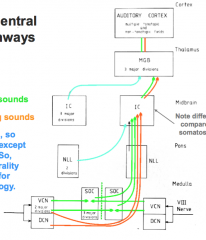
Green pathway
- CN VIII --> Ventral Cochlear Nucleus (VCN) - Superior Olivary Complex (SOC) in pons - SOC is first place for binaural convergence (L and R fibers each go to L and R SOC) - SOC projects to Inferior Colliculus (IC) in midbrain - Medial Geniculate Nucleus (MGN) in thalamus - Terminate in primary auditory cortex (A1) |
|
|
What is the pathway starting at the CN VIII for recognizing sounds?
|
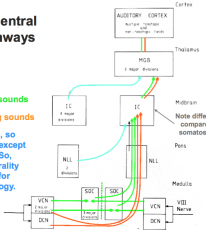
Orange pathway
- CN VIII --> Dorsal and Ventral Cochlear Nuclei (DCN and VCN) - Directly to contralateral Inferior Colliculus (IC) in midbrain via Lateral Lemniscus - Medial Geniculate Nucleus (MGN) in thalamus - Terminate in primary auditory cortex (A1) |
|
|
Which pathways originate in the Ventral Cochlear Nuclei? Dorsal Cochlear Nuclei?
|
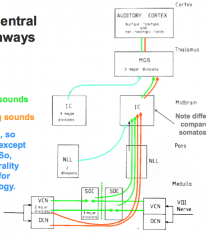
- VCN: localizing (green) and recognizing (orange) sound pathways
- DCN: recognizing (orange) sound pathway |
|
|
Which pathway projects from the cochlear nuclei to the Superior Olivary Complex (SOC)?
|
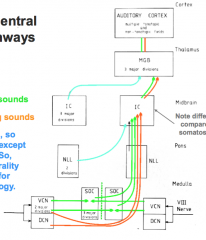
System for localizing sounds (green)
|
|
|
Which pathway has binaural convergence?
|
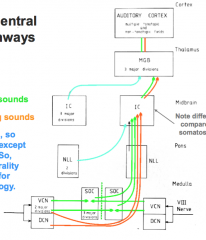
System for localizing sounds (green)
* Starts at superior olivary complex (SOC) |
|
|
What are the similarities between the system for localizing sounds and system for recognizing sounds?
|
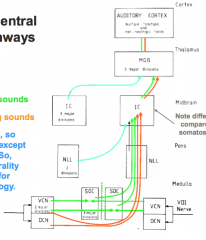
- Both go to Inferior Colliculus
- Then go to Medial Geniculate Nucleus - Terminate at primary auditory complex (A1) |
|
|
What is the location of the primary auditory cortex (A1)?
|
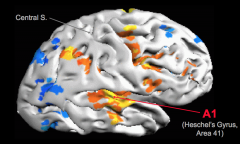
Superior Temporal Lobe, Heschel's gyrus
|
|
|
What higher order cortical area does the primary auditory cortex (A1) project to?
|

In left hemisphere, projects to Wernicke's area
|
|
|
How is the cortex for Wernicke's area different on the L and R sides?
|

- Expansion of cortex on L to accommodate Wernicke's area
- R side does not show this same expansion (found in temporal lobes) |
|
|
What is the function of Wernicke's area?
|

Speech interpretation and recognition
|
|
|
How are the topography and laterality of the auditory system used to diagnose site of damage?
|
Limited use because:
- Multiple decussations and commissures in ascending pathways - Information from each ear ascends upon both sides of the brain - Duplication of pathways makes it difficult to selectively cut afferents from one ear or from one part of frequency spectrum unless lesion occurs peripherally in cochlear nucleus |
|
|
What makes it difficult to selectively cut afferents from one ear or from one part of the frequency spectrum?
|
- Duplication of pathways
- Unless lesion occurs peripherally in cochlear nucleus |
|
|
How is the topography of the auditory system set up?
|

- Hair cells of cochlea are arranged along basilar membrane
- Hair cells at successive positions to be most sensitive to successively lower pitched tones - High freq. at base of basilar membrane - Low freq. at apex of basilar membrane |
|
|
What is the receptive field of an auditory nerve cell?
|
Region of the basilar membrane to which it is responsive
|
|
|
What is a placecode?
|
Place along basilar membrane that represents a certain pitch (frequency)
|
|
|
What is a characteristic frequency?
|
The best frequency that a cell responds to
|
|
|
What does a frequency tuning curve describe?
|

How well a cell responds to higher and lower frequencies
|
|
|
How does sound intensity affect the frequency tuning curve?
|
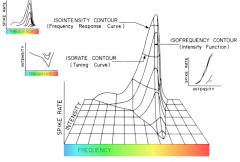
Broadens it
|
|
|
Where are there tonotopic maps?
|
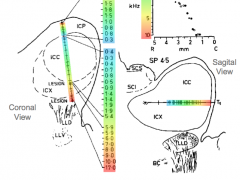
- Most auditory nuclei (e.g., inferior colliculus (ICC))
- Primary and secondary auditory cortex (A1 and A1) |
|
|
What are the two major functions of the central processing of auditory information?
|
- Recognize the sounds (what is it?)
- Localize the sounds (where is it?) |
|
|
What is the function of Broca's area?
|

Speech production
|
|
|
How do lesions of the auditory cortex affect sound sensation?
|
- Does not affect sensation of simple sounds
- Disrupts perception of complex sounds like speech |
|
|
What is "aphasia"?
|
Absence of speech but really is a disturbance of higher complex functions by which meanings are comprehended and expressed
|
|
|
How do the cells in the auditory cortex respond differently than the cells at earlier stages of processing?
|
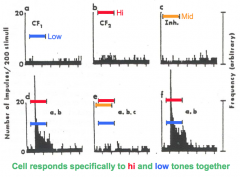
- Cells in the auditory cortex can be selectively responsive to complex features of sounds
- Some cells select for speech components (initial formant and a sustained tone) - Some cells respond to certain combinations of tones (shown in image) |
|
|
What is a speech sound composed of?
|
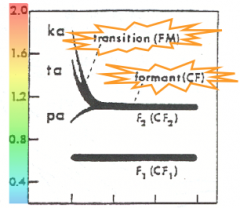
- Initial formant that changes over time
- Sustained tone - E.g., "ka", "ta", and "pa" - Only differ in the beginning, dynamic component |
|
|
What factors contribute to the ability to localize a sound source?
|
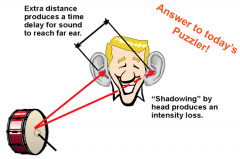
- Extra distance produces a time delay for sound to reach far ear (binaural time)
- Shadowing by head produces an intensity loss (intensity) |
|
|
What structure is specialized to detect auditory time and intensity differences?
|
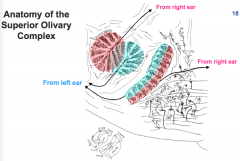
Superior Olivary Complex (SOC)
|
|
|
How do neurons in the superior olivary complex convert a binaural time difference to a place code for location?
|
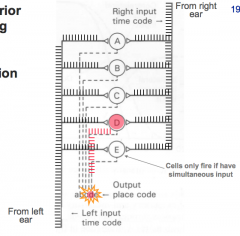
The neuron will only fire if it has simultaneous input
- Requires a "temporal coincidence" |

